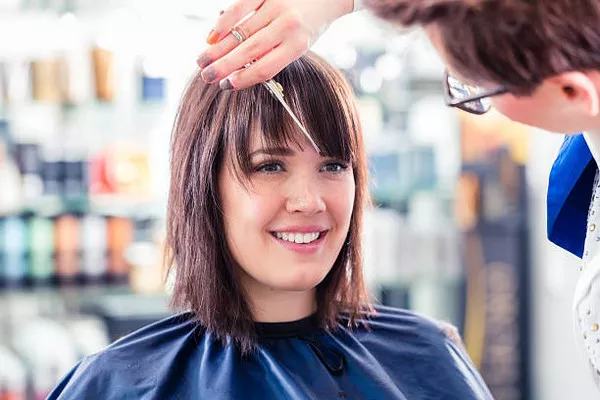Styling hair with bangs and layers can be both fun and versatile. This combination offers a chic, modern look that can be tailored to suit any face shape or personal style. In this article, we’ll explore various techniques, tips, and styles to help you master the art of styling hair with bangs and layers.
Understanding Bangs and Layers
Bangs are sections of hair cut to hang over the forehead, while layers involve cutting hair at different lengths to add volume and movement. When combined, bangs and layers can enhance your features and add dynamic shape to your hair.
Benefits of Combining Bangs and Layers
Versatility: This style works for different hair textures and lengths.
Face Framing: Bangs and layers can be tailored to highlight your best features.
Volume and Movement: Layers add body to your hair, while bangs provide a fresh, youthful look.
Low Maintenance: Depending on the style, this combination can be relatively easy to maintain.
Types of Bangs
Straight Across Bangs
Description: Evenly cut bangs that fall straight across the forehead.
Best For: Oval or heart-shaped faces.
Styling Tips: Keep them sleek with a flat iron or blow-dry for a polished look.
Side-Swept Bangs
Description: Bangs that are swept to one side, often longer than straight-across bangs.
Best For: Round faces or those wanting a softer look.
Styling Tips: Use a round brush to add volume and direction.
Curtain Bangs
Description: Bangs parted down the middle and swept to each side.
Best For: Most face shapes, especially oval or square.
Styling Tips: Use a curling iron for soft waves and volume.
Wispy Bangs
Description: Light and airy bangs with uneven lengths.
Best For: Those seeking a more relaxed, casual look.
Styling Tips: Use a texturizing spray to enhance the natural look.
Types of Layers
Long Layers
Description: Layers that start around the shoulders and extend to the ends.
Best For: Long hair or those seeking subtle volume.
Styling Tips: Add beachy waves or curls for a textured look.
Short Layers
Description: Layers cut closer to the roots for more volume and movement.
Best For: Short or medium hair.
Styling Tips: Use a texturizing spray to enhance volume and separation.
Face-Framing Layers
Description: Layers cut to frame the face, often starting around the chin.
Best For: Highlighting facial features.
Styling Tips: Use a curling iron to create soft, face-framing curls.
Choppy Layers
Description: Layers with uneven, textured ends.
Best For: Adding a punk or edgy look.
Styling Tips: Use a texturizing paste for definition.
See Also: How To Style Lob With Bangs
Styling Techniques
Blow-Drying
Preparation: Apply a heat protectant and volumizing mousse to damp hair.
Technique: Use a round brush to lift hair at the roots and smooth layers.
Finishing: Use a cool setting to lock in style and reduce frizz.
Flat Ironing
Preparation: Apply a smoothing serum to damp hair.
Technique: Straighten hair in small sections, focusing on the bangs to ensure they are sleek and smooth.
Finishing: Apply a light hairspray for hold without stiffness.
Curling
Preparation: Apply a heat protectant to dry hair.
Technique: Use a curling iron or wand to create soft curls or waves, focusing on layers for added movement.
Finishing: Lightly tousle curls with fingers for a natural look.
Texturizing
Preparation: Apply a texturizing spray or sea salt spray to damp hair.
Technique: Use your fingers or a comb to create separation and volume.
Finishing: Allow hair to air-dry or use a blow-dryer with a diffuser.
Maintaining Bangs and Layers
Regular Trims: Keep bangs and layers looking fresh with regular trims every 6-8 weeks.
Conditioning: Use a deep conditioner to maintain moisture and prevent split ends.
Heat Protection: Always use heat protectant products before styling to prevent damage.
Tips for Different Hair Types
Straight Hair
Bangs: Opt for straight-across or side-swept bangs for a sleek look.
Layers: Long layers work well to add movement without sacrificing length.
Wavy Hair
Bangs: Curtain bangs or wispy bangs can complement natural waves.
Layers: Short layers can enhance the natural wave pattern and add volume.
Curly Hair
Bangs: Side-swept or curtain bangs can work well, but ensure they are cut to accommodate curl shrinkage.
Layers: Long layers can help prevent curls from becoming too bulky.
Thick Hair
Bangs: Opt for lighter, wispy bangs to avoid adding bulk.
Layers: Choppy or short layers can reduce volume and add manageability.
Fine Hair
Bangs: Side-swept bangs or wispy bangs can add the illusion of volume.
Layers: Short layers can help create the appearance of thicker hair.
Common Mistakes to Avoid
Over-Layering: Too many layers can make hair look thin and lifeless.
Misaligned Bangs: Ensure bangs are cut evenly and styled according to your face shape.
Ignoring Texture: Different hair types require specific styling techniques for the best results.
Conclusion
Styling hair with bangs and layers can transform your look and offer a range of options for personalization. By understanding the different types of bangs and layers, as well as mastering various styling techniques, you can create a look that is both fashionable and flattering. Regular maintenance and proper care are essential to keep your style looking its best. Embrace the versatility of bangs and layers and experiment to find the perfect style for you.


